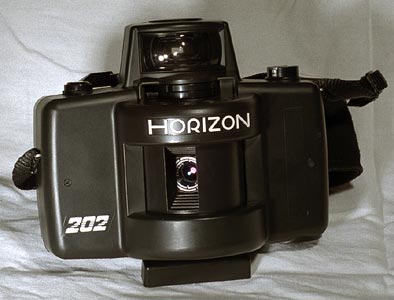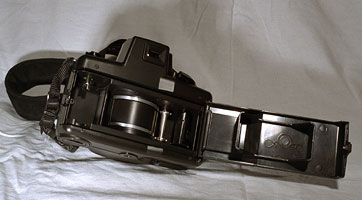
This and more can be had for little money with a Horizon.
 This camera is produced in Russia at Krasnogorsk near Moscow in the famous KMZ factory, better known for its Zenit SLRs, Zorki copies of Leica cameras and clones of various Zeiss lenses.
This camera is produced in Russia at Krasnogorsk near Moscow in the famous KMZ factory, better known for its Zenit SLRs, Zorki copies of Leica cameras and clones of various Zeiss lenses.
The principle of this camera which works with ordinary 35 mm film is very simple. Its main component is a revolving drum with the lens on one side and a slot at the opposite side. The film is positioned around the rear or inner half of the drum. In order to take a picture, the drum rotates by about 180 degrees and the slot in the rear sweeps across the piece of film to be exposed. The result is a negative of the usual width of 24 mm but with a length of 56 mm.
The different shutter speeds are generated by varying the width of the rear slot in combination with with two switchable speeds of the drum rotation.
With its 2.8/28 mm lens, the Horizon covers a horizontal angle of 120 degrees. The optical quality is excellent and by far exceeds that obtained by cropping normal 35 mm or APS negatives along the top and bottom.
This is a rangefinder camera and one of its most important features is the spirit level built into the viewfinder. With the wide angle of the frame, even the slightest tilt sideways becomes immediately apparent and any upwards or downwards inclination results in strong curvature of the horizon. Hence, the horizon needs to be positioned right across the middle of the picture. Not exactly a model of classical composition but there's only one way around this and it's quite expensive: Noblex make panorama cameras with shift lenses.
Loading the film requires a little practice because the film path is more complex than with a normal 35 mm camera. And after the first film or two, I even learned to keep my fingers out of the picture. Vertical shots, however, will almost inevitably include your feet or belly... depending on your stature. :-)
We all know about the merits of cleanliness with optical equipment but here it's twice as important. Any little speck of dust on the lens which would be either invisible or just show up as a tiny spot with a normal camera will be swept all across the frame and result in a long straight line.
One must be aware that flare can be a problem with all panoramic cameras. The angle covered by their lenses is much wider and this means one is always a little closer to the sun, at one side of the frame. Often enough, half of the frame is what would be a backlit shot with a normal camera. Pointing the Horizon in the direction of the sun isn't a problem as long as the sun is high enough. In deepest winter or around dusk or dawn, there is considerable danger of the sun shining directly through the lens and sweeping across the inside of the camera, This can even affect some of the film from earlier frames on the take-up spool. I've had a few shots ruined by this. Remember, this is due to the principle of such cameras and has nothing to do with inferior communist design (TM).
And once I've mentioned this, here's a word of caution to the prospective buyer. Like many cameras from the former USSR, the Horizon is capable of great results and a long life. BUT it should only be bought from a renowned dealer who offers a warranty and/or some kind of return policy. Now, go and buy yours from ebay, a Leningrad taxi driver, or the Polish street market in Berlin if you think you must - but don't say I haven't warned you.
I have heard people complain about light leaks along the felt strips to both sides of the rotating drum and the occasional transport failure. I haven't had any of these problems and the only instance of frame overlap which I've had could clearly be traced to wrong handling - I had inadvertently put one finger slightly on the rewind release knob and thus had partially disengaged the transport mechanism. My only real complaint was that they had apparently forgotten to de-burr the film guiding rails inside my camera, i.e. the two bright silvery rails visible on the picture above. They caused deep scratches along the edges of the film and a lot of dust before I defused them by very gentle treatment with a sharp steel blade.
More information about this camera can be found at a selection of sites mentioned on the 'Links' page. Just let me add a few words for those facing the dilemma I was in, before I bought my Horizon. Yes, a Noblex does indeed look much more sophisticated and the totally noiseless run of the drum is impressive. Sure, the Horizon is a little crude and the clockwork sounds awful. But the Noblex needs batteries with all the problems this entails and its drum takes ages to reach its speed and take the picture. Its delay is far worse than that of any digital autofocus camera. And only the top Noblex models have slow speeds below 1/60 sec. Combine this with the f4.5 lens and the 'cheaper' Noblex cameras can only be used in bright daylight. All this for three or four times the price of my Horizon. Thanks, but I'd rather not.
Now, to complete the description of this camera, here's a quick run-down of its key specifications:
| film format | 35 mm, 22 exp. per 36 exp. roll | horizontal angle | 120 degrees | |||
| frame format | 24 x 56 mm | focussing | fixed, supposedly at infinity, DoF: 1 m to infinity at f16 | |||
| lens | 2.8/28 mm | shutter speeds | slow: 1/2, 1/4, and 1/8 sec.
fast: 1/60, 1/125, and 1/250 sec. |